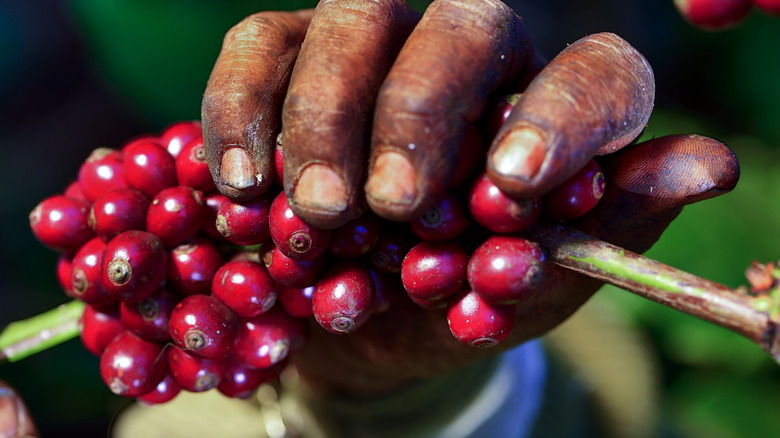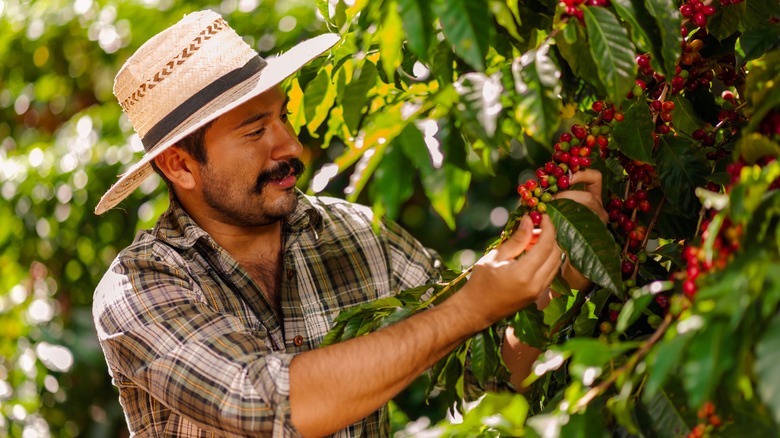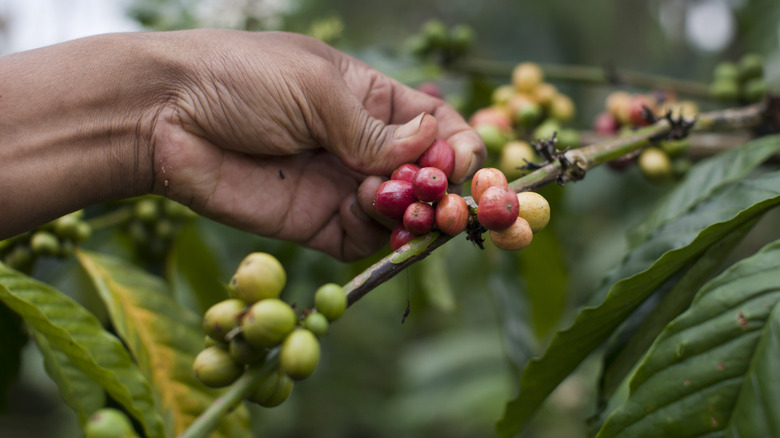The Difference Between Arabica And Canephora Coffee Species
Even if you're not a die-hard coffee lover, chances are you've come across the names "arabica" and "robusta" before. There are between 25 to 100 varieties of coffee plants worldwide, but according to the World Coffee Research, a whopping 60% of the world's coffee production hails from Coffea arabica plants, with the remaining 40% sourced from Coffea canephora, also known as robusta.
For many, choosing between arabica and robusta goes beyond just availability or price: It's also about flavor preferences. These two species — despite looking sort of similar once roasted — actually offer vastly different taste profiles and aromas. Naturally, this has sparked pretty heated debates over which one reigns supreme as the ultimate coffee bean.
But we won't try and settle that debate today. If you're wondering which type of coffee you should try out the next time you stroll by your local roastery, here's what you should know the difference between these types of coffee beans, just so you'll be better equipped to pick the right one that best matches your taste buds.
For a smooth brew, try Arabica
Discovered in the highlands of Ethiopia, Arabica coffee earned its name when it journeyed from Africa across the Red Sea and found cultivation in the Arabian Peninsula during the 7th century. As a plant, Coffea arabica shrubs are very delicate and require a cool climate to grow properly. Particularly, the ones found in mountainous highlands resembling its Ethiopian origins. While Coffea arabica take more effort to grow than the Coffea canephora shrubs that give robusta beans, farmers cultivating Coffea arabica are rewarded with coffee beans that are generally regarded as offering a smoother flavor.
Arabica's flavor is highly diverse and will differ depending on the specific cultivar and the terroir. There are batches with mellow and sweet tastes, as well as batches with sharper, more acidic tastes. Nonetheless, most coffee-tasting experts can agree that good arabica always carries a distinctive acidity on the palate, followed by a gentle bitter aftertaste. Arabica is also celebrated for its great aroma once roasted, often described as berry-like and floral.
Thanks to its mild characteristics, brews made from arabica beans tend to be smooth-tasting. This quality explains why Arabica, despite being more challenging to cultivate and often pricier, remains a global favorite.
Robusta for a robust cuppa
Robusta coffee's best offering is right in the name: A robust brew for days when you really need that extra jolt of caffeine. Originating from central and western Africa, Robusta beans are favored by many for their ability to thrive at lower altitudes and their hardiness compared to arabica, which reduces growing costs and is also the reason robusta tends to be cheaper.
The most prominent flavor characteristic of robusta is its bitterness, which can be overwhelming to those trying it black for the first time. This bitterness is due to robusta's significantly higher caffeine content, which is almost double that of arabica. While the tasting notes of robusta vary, they often include oatmeal-like flavors or hints of dark chocolate. If you've ever sipped on an intensely energizing coffee drink like Vietnamese iced coffee and found it unusually strong, chances are high that it was made from robusta beans.
When comparing arabica and robusta, it's evident that each has its unique qualities and appeal. Arabica offers smooth, complex flavors for those who enjoy a subtle coffee experience; while robusta's bold qualities cater to those craving a stronger cup. Regrettably, the boldness of robusta alienates a lot of drinkers who dislike its potency, leading to its reputation as the "inferior" bean. When sourced well and brewed properly, though, both types of coffee can find a place in your pantry to be taken out and savored depending on your mood and time of day!


